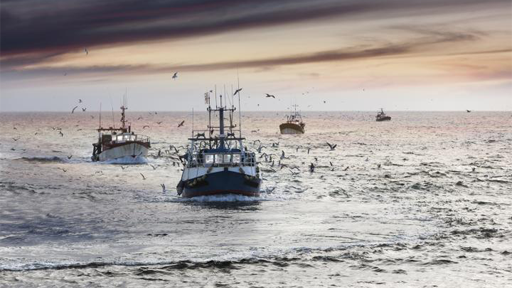An April 17 Executive Order President Donald Trump calls for suspending or revising regulations on the U.S. seafood industry, saying that regulations “overly burden” America’s commercial fishing and fish processing industries, as well as the nation’s aquaculture industry.
While the commercial fishing industry generally applauds this step, some environmental groups worry that fish populations, already falling in abundance, could be impacted if regulations are lifted and harvest is opened in protected areas of the ocean.
The President has issued some 140 Executive Orders and directives since taking office Jan. 20 and this EO is one of the latest.
“The United States should be the world’s dominant seafood leader,” the President said when signing the EO, and saying that the nation’s seafood trade deficit is more than $20 billion.
Restoring the American Seafood Industry, as Trump’s EO is called, directs NOAA Fisheries to:
- Incorporate better, cheaper, more reliable technologies and cooperative research programs into fishery assessments.
- Expand exempted fishing permit programs to promote fishing opportunities nationwide.
- Modernize data collection and analytical practices to improve the responsiveness of fisheries management to real-time ocean conditions.
The EO is at https://www.whitehouse.gov/presidential-actions/2025/04/restoring-american-seafood-competitiveness/
The EO “strengthens the U.S. fishing industry by reducing regulatory burdens, combating unfair foreign trade practices, and enhancing domestic seafood production and exports,” a White House fact sheet says. “The Order establishes an America First Seafood Strategy to boost U.S. seafood production, sales, and exports, ensuring long-term industry growth and global competitiveness.”
It says that Trump recognizes that overregulation and unfair trade practices have eroded the U.S. fishing industry’s global leadership. While U.S. controls over four million square miles of fishing grounds, it imports nearly 90 percent of its seafood and that results in a trade deficit of over $20 billion.
Further, the EO says that the U.S. seafood industry is one of the most heavily regulated sectors in the United States, with restrictive catch limits and outdated data hampering American fishermen’s productivity. To further trouble U.S. fishing, illegal, unreported and unregulated fishing, forced labor in foreign seafood supply chains and unfair trade practices abroad all undermine U.S. markets.
According to an Associated Press report, some environmental groups said the Magnuson-Stevens Fishery Conservation and Management Act has guided U.S. fishery management for nearly 50 years and was intended to combat overfishing.
Further, they said, the number of fish stocks on the federal overfished list grew from 40 in 2013 to 47 in 2023; conservationists said they fear that number will grow with weakened regulations.
“These executive orders don’t loosen red tape – they unravel the very safety net that protects our oceans, our economy, and our seafood dinners,” Beth Lowell, vice president of Oceana, a conservation group, told the Associated Press. “For decades, the U.S. science-based approach to fisheries management has rebuilt declining stocks, kept American fishers on the water, and protected important places and wildlife.”
The seafood industry is generally in favor of the Executive Order.
“The [EO] outlines key actions to benefit every link in the supply chain – from hardworking fishermen to parents who serve their family this nutritious and sustainable protein at home,” National Fisheries Institute President and CEO Lisa Wallenda Picard told Seafood Source News. “Importantly, the EO calls for reducing unnecessary regulatory burdens on fishermen and seafood producers while also promoting the many benefits of eating seafood as part of a healthy, balanced diet.”
U.S. Senator Dan Sullivan (R-Alaska) called the new executive order a “shot in the arm” for the U.S. seafood industry and said it will provide relief for fishermen.
“These great Alaskans have endured a perfect storm of challenges, which include unfair seafood trade practices by dictatorships like Russia and China, and onerous regulatory burdens from our own federal government,” Sullivan said in a statement. “I have been working relentlessly with the Trump administration, including with the Commerce and Agriculture Departments, and the U.S. Trade Representative, to get relief for our fisherman. They listened.
“Today, President Trump gave our fishermen a major shot in the arm, ordering his administration to remove unnecessary federal red tape and develop an America First Seafood Strategy with measures to enhance the competitiveness of our seafood in global markets and hold bad actors in seafood trade accountable. I appreciate the Trump administration’s continued strong focus on advancing the interests and priorities of Alaska across a range of economic sectors, including our fishermen and coastal communities.”
However, some in the seafood industry worry that cuts at NOAA will make it difficult to for the agency to complete many of the tasks outlined in the EO, especially given some of the short timelines proposed by Trump, according to an article this week in SeafoodSource News.
“NOAA has already lost so many people as a result of the probationary cuts, and even more will be retiring early,” Stimson Center Senior Fellow and Director of its Environmental Security Program Sally Yozell told SeafoodSource.
She is referring to the tasks laid out by Trump’s order for NOAA that could overwhelm an agency reduced by staff cuts from both Elon Musk’s Department of Government Efficiency and the Trump Administration. She said that the firing of NOAA employees “en masse” have already had impacts on commercial fisheries and fishers.
Yozell said the Reduction in Force (RIF) plans are still unknown for NOAA and its line officers, and the EO’s multi-faceted goals of expanding aquaculture, boosting fishing, and bringing processing back to the U.S. is a “laudable but very tall order” that would require a high degree of expertise, SeafoodSource reported.
The EO establishes an America First Seafood Strategy, a trade strategy to address unfair trade practices, a seafood import monitoring program and it orders a review of all existing marine national monuments to assess opening them to commercial fishing.
An April 22, 2025 Federal Register notification of the Executive Order is here: https://www.federalregister.gov/documents/2025/04/22/2025-07062/restoring-american-seafood-competitiveness

